
Posted on 02/12/2011 5:14:07 AM PST by Homer_J_Simpson

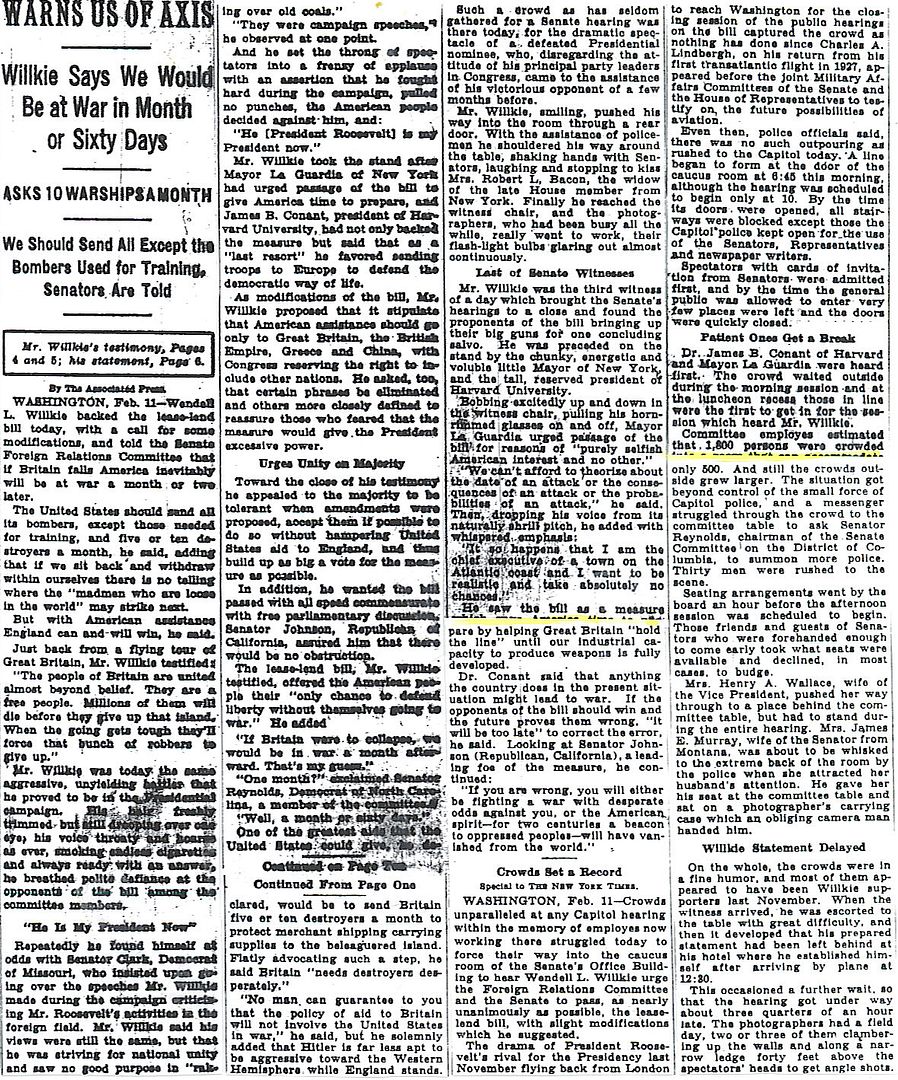
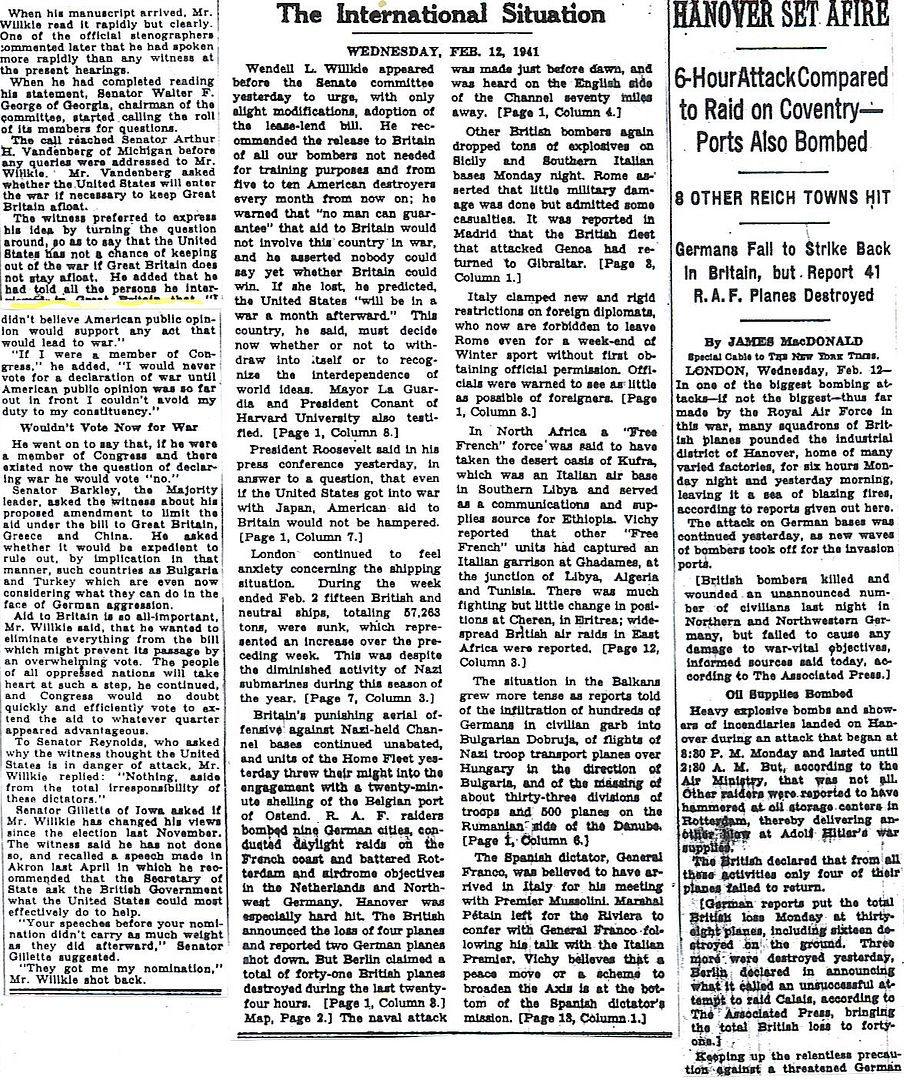
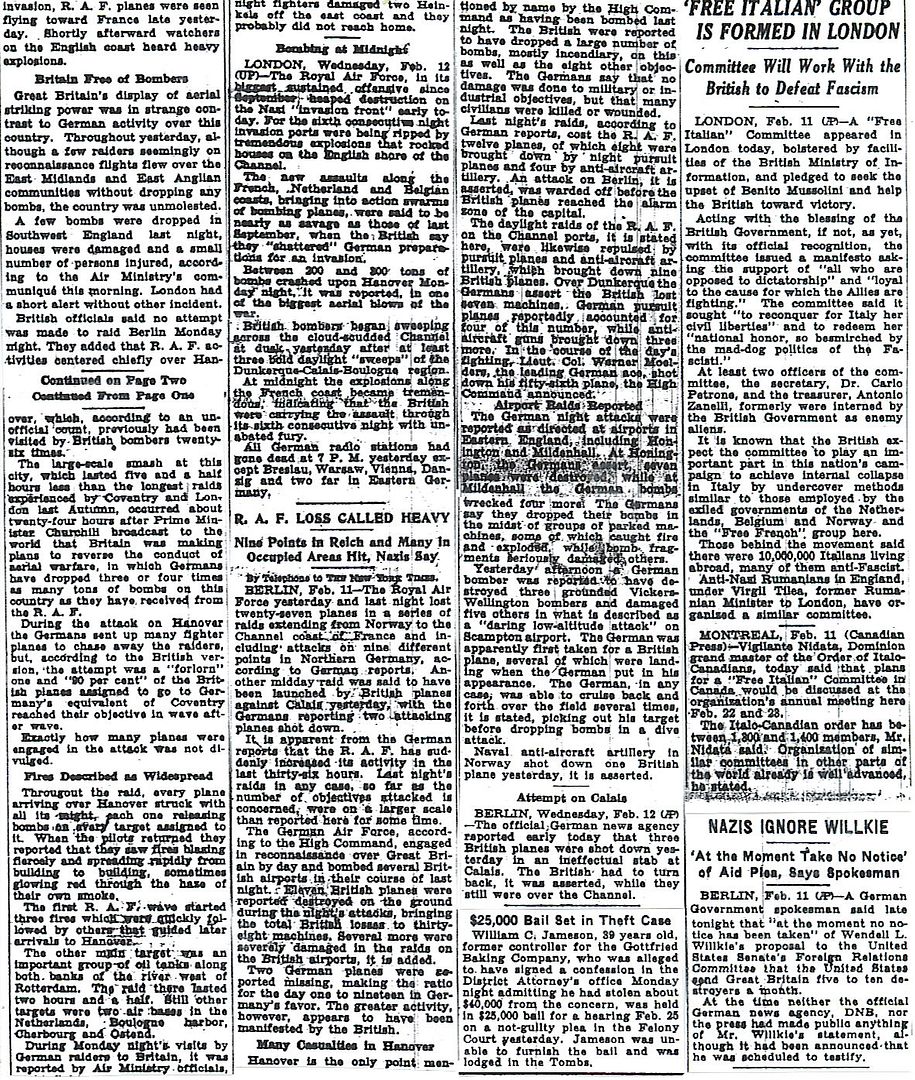
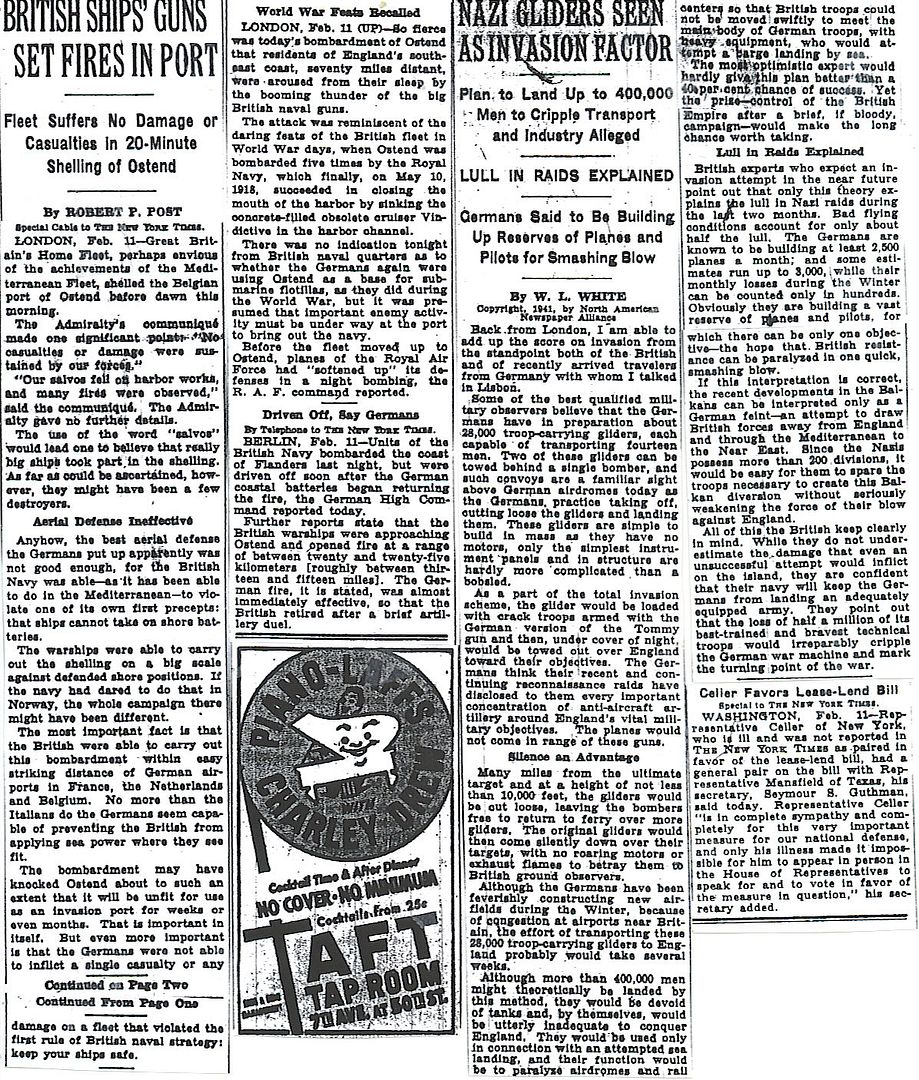
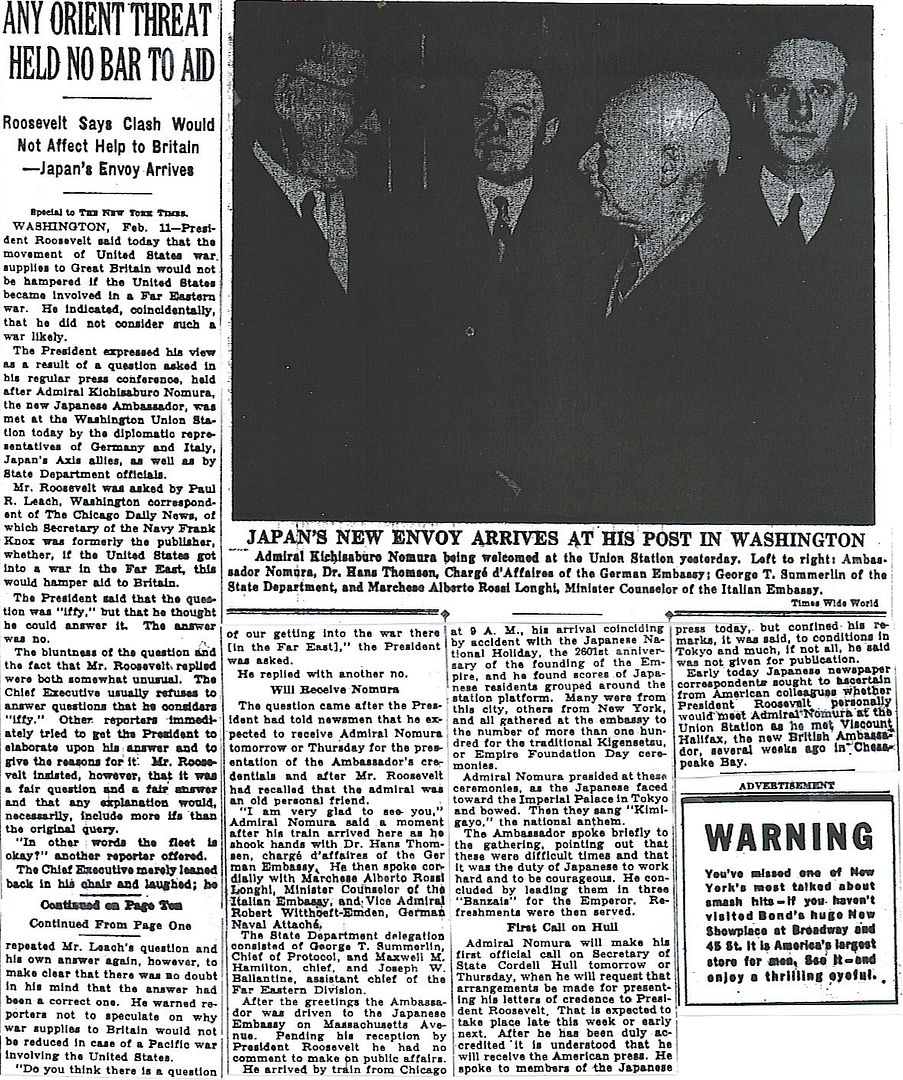
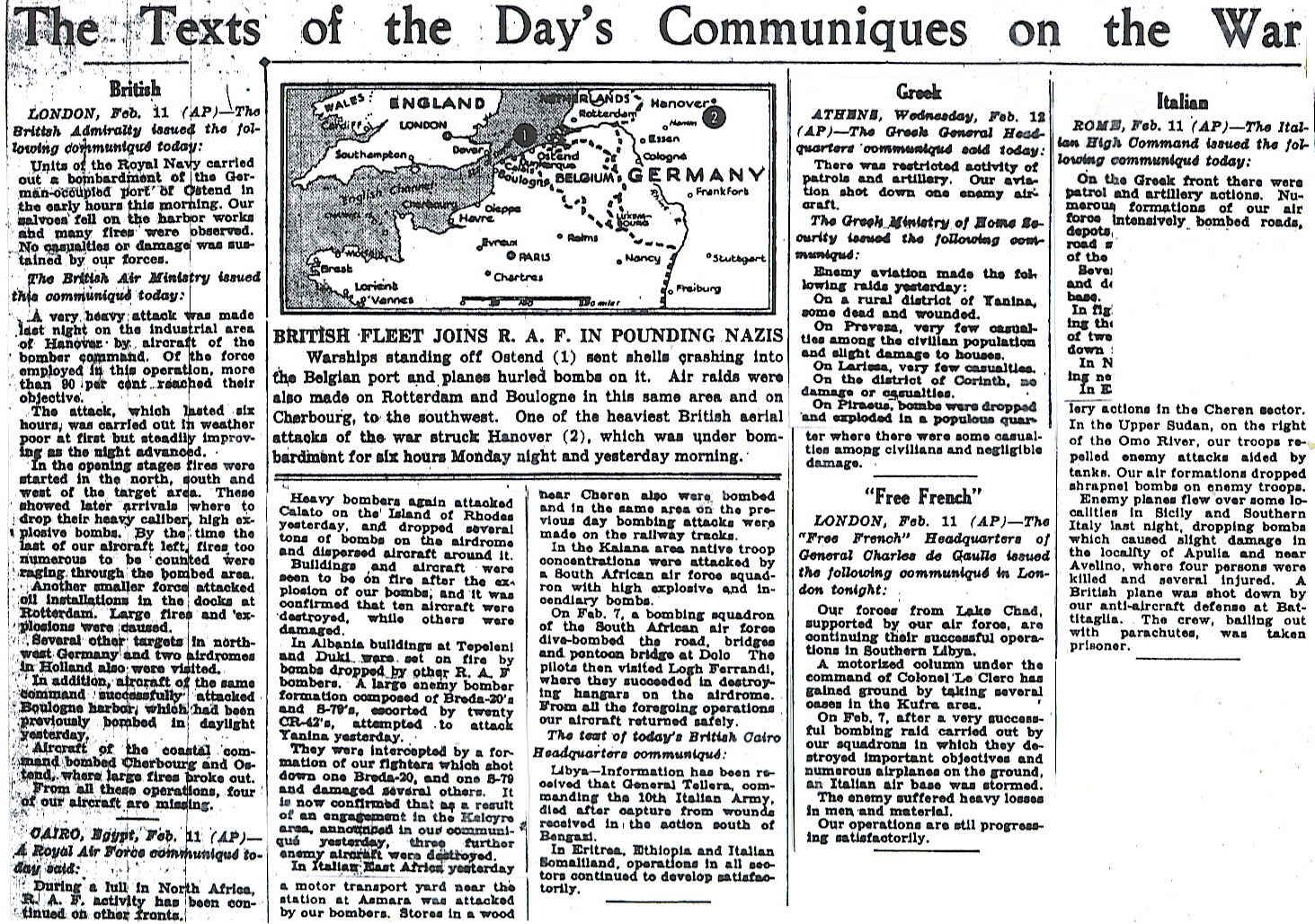
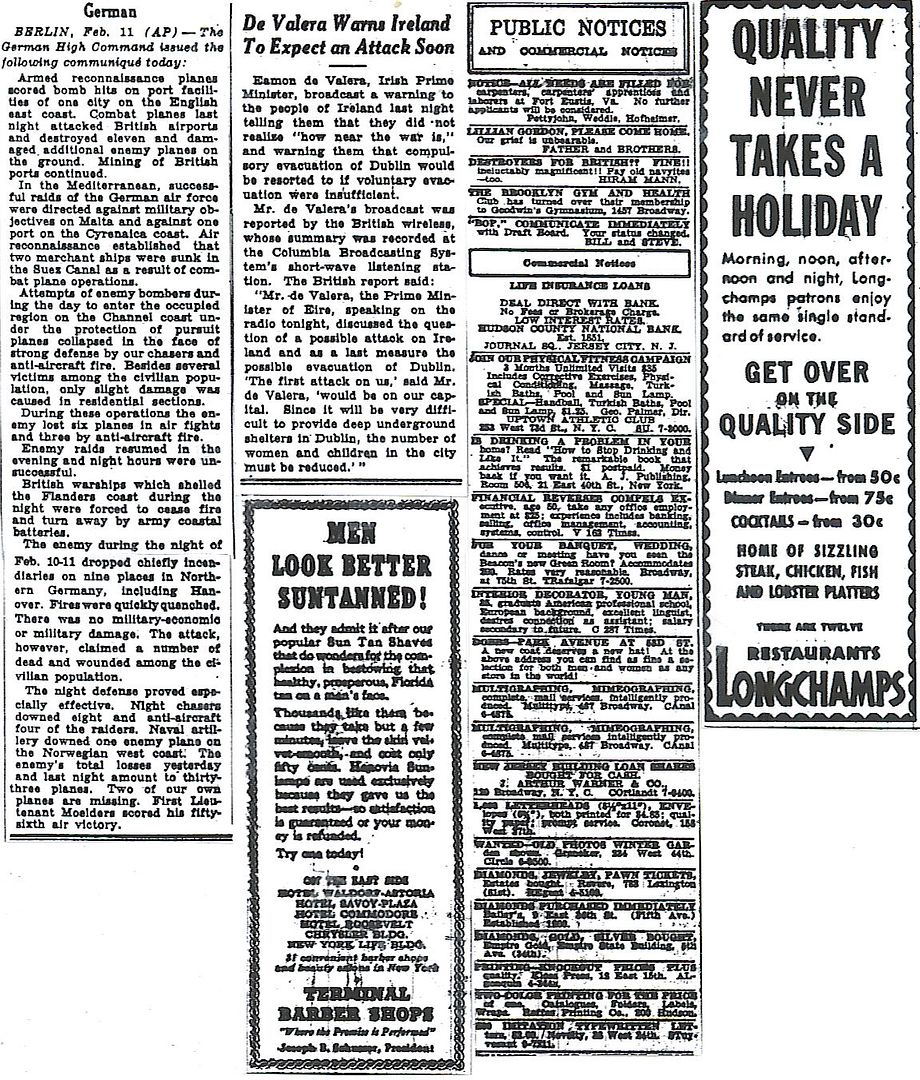
* There are two tragic copying incidents effecting today’s post. We missed the bottom line of text across three columns on page 10. The three places marked in yellow each indicate one missing line in the lead story. And the Italian communiqués are marred.
http://www.onwar.com/chrono/1941/feb41/f12feb41.htm
New Axis leaders for North Africa
Wednesday, February 12, 1941 www.onwar.com
In North Africa... General Rommel arrives in Tripoli. Nominally more important is the appointment of the new Italian Commander in Chief for Libya, General Gariboldi. Field Marshal Kesselring is in Rome as the German representative.
In the North Atlantic... The convoy SLS-64 of 19 ships is attacked by the German heavy cruiser Admiral Hipper. Seven of the ships are sunk.
In Moscow... General Zhukov is appointed Chief of the General Staff and Deputy Commissar for Defense. General Meretskov is now to lead the Red Army’s training directorate.
Hobart will make a significant contribution to eventual victory with the ‘funnies’, specialized and equipped Shermans he developed, at D-Day and beyond.
Churchill will make the same mistake a year later, with the 8th Army at the same place [El Agheila], by stripping it of assets for Singapore.
And my childhood idol, the God of tankers, has finally arrived in Africa!
Thanks for the post!
http://homepage.ntlworld.com/andrew.etherington/month/thismonth/12.htm
February 12th, 1941
UNITED KINGDOM: Anthony Eden and General Dill leave for a tour of Greece, Turkey and Egypt.
London:
Free French Headquarters announced:
Our forces in Chad Province [French Equatorial Africa] have continued their operations in southern Libya with the support of our aircraft. A motorised column under the command of Colonel Leclerc has won ground and occupied bases around Kufra.
Almost 600 miles of desert separate Kufra from the border of Chad, and the Sahara poses many obstacles to military operations in the area.
The Belgium government-in-exile breaks diplomatic relations with Romania. (Jack McKillop)
Corvettes HMS Aster and Starwort launched.
Destroyer HMS Penn launched.
Corvette HMS Amaranthus commissioned.
Minesweeper HMS Bude commissioned.
(Dave Shirlaw)
GERMANY:
U-301, U-659 laid down.
U-651 commissioned. (Dave Shirlaw)
ITALY: The Italian government asks that U.S. consulates at Palermo and Naples be moved to Rome rather than be located on a sea coast.
Spanish Dictator General Francisco Franco and Italian Premier Benito Mussolini confer in Rome “on all problems interesting the two governments at the present historic moment.”
ROMANIA: Bucharest: With at least 40 troop trains a day crossing Hungary to Romania, Hitler is set to build up a formidable 600,000-strong army on the border with the Ukraine. Much of the equipment carried by the German forces is of French make, having been seized after the French collapse last year.
The Germans’ next move, now the ice has broken on the Danube, is to float pontoon bridges in the river to enable troops to enter Bulgaria, under a secret agreement reached with the Bulgarian government four days ago. The Germans have promised the Bulgarians a slice of Greek territory to give them access to the Aegean Sea - but only after the war.
The massive German move into the Balkans has set off a wave of speculation that Hitler may be about to go to the rescue of his Italian ally, who has been badly mauled by the Greeks. Some observers, however, believe that Hitler, despite his treaty of friendship with Stalin, is planning to invade the Soviet Union.
U.S.S.R.: Soviet submarine M-122 launched. (Dave Shirlaw)
LIBYA: Tripoli, LIBYA: General Erwin Rommel arrives to take command of the armoured section of the Deutsches Afrika Korps. This section will comprise a Panzer and a Motorised Infantry Division. He assumes command and receives assistance from the Fliegerkorps X and long range aircraft from Sicily to fight the exhausted British. The German 5th Light Division includes 9,300 Germans, 130 tanks, 111 guns and 2,000 vehicles (80 German aircraft are also included). The Italian “Ariete” and “Trento” Divisions arrive as well. The “Ariete” is composed of 6,949 men, 163 tanks, 36 field guns, 61 anti-tank guns and the Brescia Infantry Division. Rommel has 100,000 Italians, 7,000 Italian trucks supplying munitions to the front, 1,000 Italian guns and 151 Italian aircraft. Garibaldi is named Commander in Chief for Libya. (Jack McKillop)
ERITREA: Keren: Subadar Richpal Ram (b. 1899), 6th Rajput Rifles, displayed great bravery leading an attack in which he died. He had shown similar courage in an assault five days earlier.
The town of Afmadu, about 100 miles north of Kismayu is taken by the King’s African Rifles.
Italian alpine troops recapture positions at Keren, forcing British forces to retreat.
AUSTRALIA: Destroyer HMAS Nestor commissioned. (Dave Shirlaw)
U.S.A.: It is reported that there are 858 corporations and 1,091 corporation executives in the US accused by the government of criminal violation of anti-trust laws. It is also shown that the government had indicted 84 unions and 336 union officials on similar charges.
U.S.S.R.: Moscow: General Georgi Zhukov is appointed Soviet Chief of the General Staff and deputy commissar for defence. The former Chief of the General Staff, General Kirill Meretskov is named Deputy People’s Commissioner for Defence. (Jack McKillop)
ATLANTIC OCEAN: Far to the west of Gibraltar Admiral Hipper sinks seven ships from unescorted convoy SLS64 bound for Britain from Sierra Leone. She then returns to Brest, and in March heads back to Germany via the Denmark Strait to take no further part in independent commerce raiding.
M/S Borgestad NS (3924 grt Built in Copenhagen, Denmark 1925.) Captain Lars Grotnæss, Commodore ship in Convoy SLS 64, with a cargo of cotton. Captain Grotnæss must have given the order to disperse, because ship after ship turned around and desperately tried to get away, but Borgestad and the other ships at the head of the convoy had no time for such manoeuvres, as Hipper was quickly advancing, and Grotnæss chose to fight, in spite of Borgestad’s inferior armament. He headed directly towards Admiral Hipper, in an effort to get that ship as far away from the convoy as possible, with the gunners loading and firing, loading and firing. Borgestad sank, 30 men and 1 woman went down with her. Other ships lost were the Greek Perseus, 14 died, the British Derrynane, 36 died - Schrewsbury, 20 died, Oswestry Grange, 5 died - Warlaby, 36 lost and Westbury with 5 dead. The 1st mate on Borgestad, Harald Nergaard had his American wife Norma (born Hayes) with him on the ship. She was employed as a stewardess, was 21 years old and from Tacoma. The captain was posthumously awarded the highest ranked Norwegian decoration “Krigskorset” for his actions during this battle, which were officially acknowledged as having saved the convoy from total destruction by Hipper. (Dave Shirlaw)
The submarine HMS Snapper after leaving her escort off Lands End for Bay of Biscay is not heard from again, she is believed lost on mines. However it is also possible that German warships sank her since a submarine attacked the German minesweepers M-2, M-13 and M-25 on the night of the 10/11th February in the area where Snapper might have been. The submarine was subjected to a counterattack in which 56 depth charges were dropped.
Polish destroyers Piorun, Garland and the British destroyer HMS Legion conduct an offensive patrol against enemy submarines. However, no U-boat was encountered. (Dave Shirlaw)
http://worldwar2daybyday.blogspot.com/
Day 531 February 12, 1941
The balance of power changes in North Africa. Operation Compass is stopped. Following the previous pattern, General O’Connor sends Colonel Dorman-Smith to Cairo to get British Commander-in-Chief Middle East General Wavell’s permission for the next advance. Wavell is under instructions from Churchill to divert troops from Libya to Greece and when Dorman-Smith arrives, he finds maps of the Balkans replacing maps of North Africa on the wall at Wavell’s HQ. British Foreign Minister Anthony Eden and CIGS Sir John Dill leave London for Cairo to coordinate military assistance to Greece. Operation Sonnenblume begins. Rommel arrives in Tripoli. Another convoy of Afrika Korps troops leaves Naples aboard steamers Adana, Aegina, Kybfels & Ruhr, escorted by Italian destroyer Camicia Nera and torpedo boat Procione, and will reach Tripoli on February 14.
At 6.18 AM 800 miles West of Gibraltar, German cruiser Admiral Hipper attacks convoy SLS64, sinking 7 steamers (British Warlaby, Westbury, Oswestry Grange, Shrewsbury, Derrynane plus Norwegian Borgestad and Greek Perseus, 116 crew killed). At 7.40 AM, Hipper breaks off, almost out of 203mm shells, as rain and fog hide the scattering ships.
Battle of Keren, Eritrea, East Africa. There is fighting again around Cameron Ridge on the North side of Dongolaas Gorge and in Happy Valley on the South side (Subadar Richhpal Ram of the 6th Rajputana Rifles wins the Victoria Cross posthumously for leading assaults on Acqua Col at the end of the valley on February 7 and 12).
Some of his ideas worked better than others. On D-Day, in particular, there were mixed results.
Liddell Hart clearly believes Churchill screwed the pooch with his shift of focus to the lost cause in Greece. Although, at this point the Germans have yet to move to the Balkans in force. A few other accounts I have read essentially agree that it was a mistake. But just how important of a blunder was it? I see a nice "What if" opportunity here. IF the British had left Greece to her fate and consolidated their gains in Libya how would the course of the war in the ETO have gone differently? Would Rommel have been left without a beachhead to begin preparing for the assault on Tobruk? Would the back and forth desert war not have developed? Would the first American operation have been an invasion in France or Italy instead of North Africa?
A key point that most don't realize is that while Rommel's force in Africa started relatively small -- a mere corps of less than 100,000 Germans, compared to three different army groups of over three million troops total in the invasion of Soviet Russia -- Rommel's was by far the most mechanized German operation anywhere.
Indeed, Rommel's forces consumed a significant portion of all the available German mechanized forces.
If I remember, that was at least one-third.
So, when you are doing your "what if's", consider this: what if Rommel's forces had not gone to Africa, but had been added instead to those invading Russia.
How then would the Battles of Leningrad & Moscow in 1941 or the Battle of Stalingrad in 1942 have turned out?
After December 7, 1941, Japan's new Ambassador Nomura was accused of negotiating in bad faith.
Prange says Namura didn't know what the Japanese high command was planning.
So, by failing to exploit their success in North Africa the British might thereby have taken away the crucial edge the Germans needed to take Moscow in December. Churchill was craftier than I imagined.
Of course, after June 1941, Stalin did not admit that Britain was doing anything significant in the way of a Second Front.
But I would suggest that the rough ratio two to one in German armored forces engaged against the East versus the West actually remained fairly constant, from June 1941 until the war's end.
So, how crafty was Churchill?
Well, his efforts to save the Balkans proved a lost cause, though some historians claimed Churchill's moves there delayed Hitler's invasion of Russia long enough to force its failure.
But I don't think so...
We are left with two positive results that I can think of:
So, was Churchill super-crafty, or just lucky, that out of a seeming disaster in the Balkans, came a few good strategic results?
I suspect that both Churchill and Roosevelt understood a lot more about axis power intentions than we today give them credit for.
Rommel’s troops were insignificant and have vanished in the USSR, and made no “game changing” impact. His “motorization” would have been farmed out to all the other units competing for such resources. Rommel himself would probably not have risen to more than corps commander, maybe army level. He would never have been awarded his baton.
Rommel’s armor in 1941, comprised 10% of Germany’s armored strength [2 of 20 panzer divisions].
Statistically it would stand to reason that as a matter of percentages than Rommel’s small force would be more mechanized that 3 army groups. It’s not really a equal comparison.
Having Rommel’s forces in Russia definitely would only had been a drop in a bucket and would not had turned the tide. There was a lot more wrong with BARBAROSSA that could not be solved by the additions of such a small force.
By my count, Guderian's and von Kleist's Panzer Groups each had five panzer divisions.
But Hoth's & Hoepner's only had three each.
So Hoth's 3rd Panzer Group fought the Battle of Moscow in December 1941 with just three panzer divisions.
I'm only saying: suppose Hoth had Rommel's two panzer divisions also -- might that make the difference between victory and defeat?
I would also suggest that given the logistical problems of supporting Rommel in Africa, and frequent loss of supplies in transit to Rommel, that the actual costs for Rommel's two panzer divisions was higher than, say, two of Guderian's panzer divisions in Russia.
So bottom line: Rommel's Africa Corps, later included in the Panzer Army Africa, and then the Army Group Africa, became a more significant drain on German resources than it's original two armored divisions might suggest.
By the time Hoth, Hoeppner and to a much lesser degree, Guderian, were attacking toward Moscow, they had to leave fires lit under the engines of their tanks, or leave the engines running all night, to make sure they would start in the morning. Adding Rommel's divisions to the mix would just have exacerbated the problem, and left the British in control of North Africa.
Was supplying Rommel a drain? Yes. But part of that problem was caused by the fact North Africa was viewed as a sideshow in Berlin. On the few occasions when the Germans were prepared to make the effort, and provide the resources to protect Rommel's trans-Mediterranean supply line, the supplies got through. And one could argue that in the grand scheme of things, the Suez canal was strategically of greater importance than Moscow.
Disclaimer: Opinions posted on Free Republic are those of the individual posters and do not necessarily represent the opinion of Free Republic or its management. All materials posted herein are protected by copyright law and the exemption for fair use of copyrighted works.